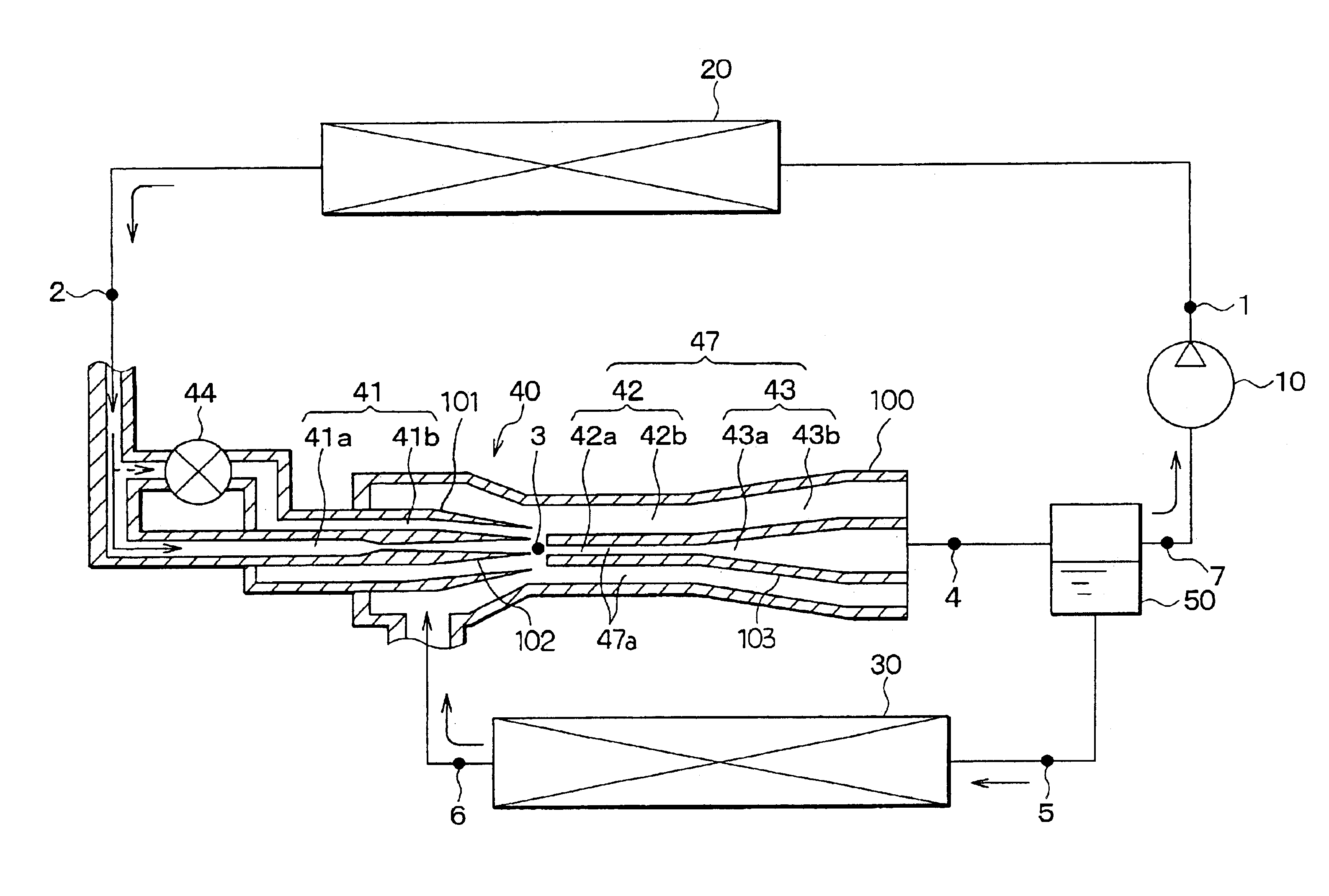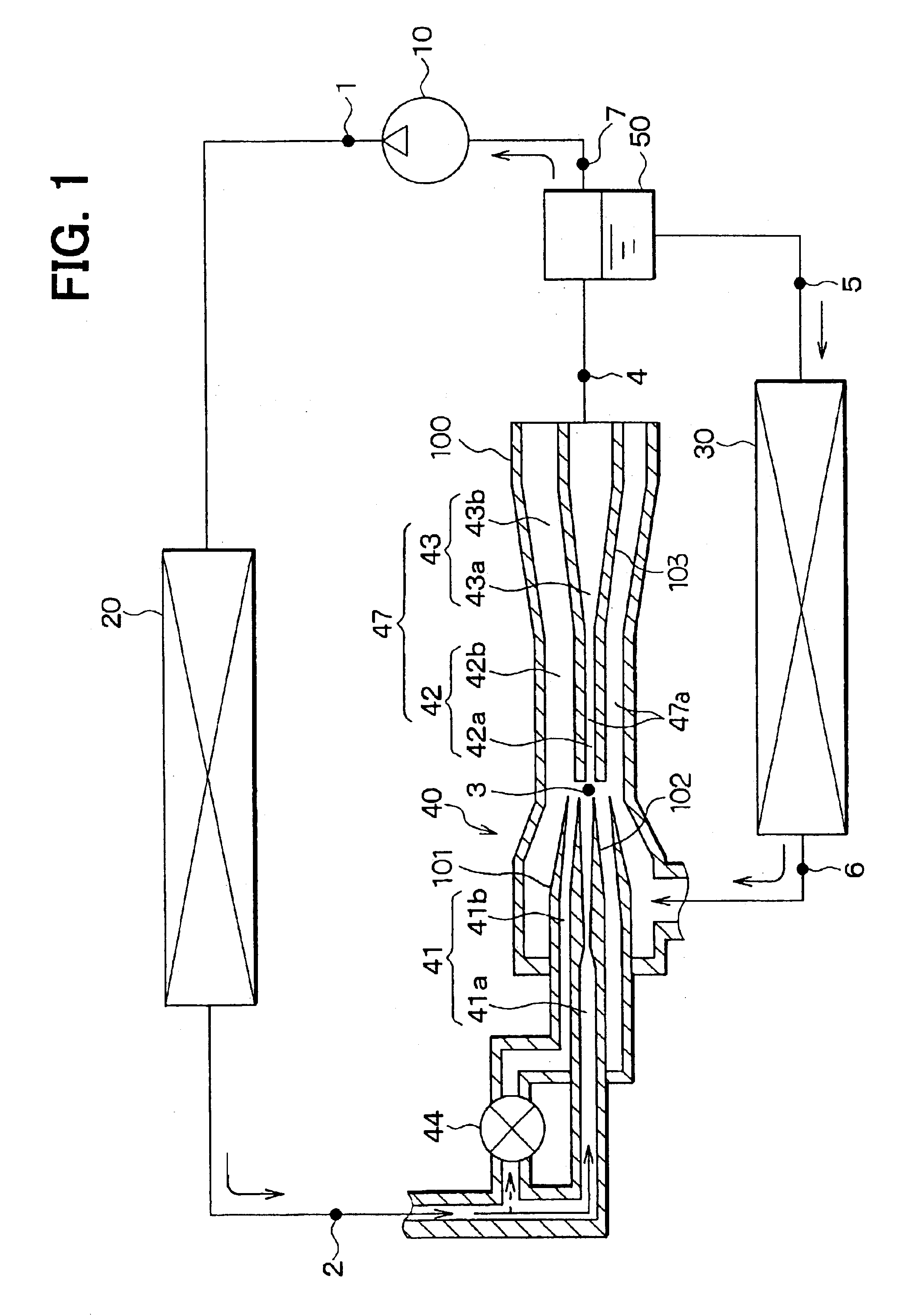Ejector-type depressurizer for vapor compression refrigeration system
a refrigeration system and ejector-type technology, which is applied in the direction of refrigeration components, machines/engines, lighting and heating apparatus, etc., can solve the problems of reduced ejector efficiency, insufficient increase of compressor intake pressure, and insufficient reduction of compressor power consumption, etc., to achieve high ejector efficiency
- Summary
- Abstract
- Description
- Claims
- Application Information
AI Technical Summary
Benefits of technology
Problems solved by technology
Method used
Image
Examples
first embodiment
(First Embodiment)
[0039]In a first embodiment of the present invention, an ejector-type depressurizer, i.e., an ejector for an ejector cycle of the present invention is embodied in a vehicle air conditioning system. FIG. 1 schematically shows an ejector cycle according to the first embodiment.
[0040]With reference to FIG. 1, a compressor 10 is a variable displacement compressor of a known type, which is powered by a drive engine of a vehicle to draw and compress refrigerant. Alternatively, the compressor 10 can be an electric compressor driven by an electric motor. A radiator 20 is a high pressure side heat exchanger. In the radiator 20, heat is exchanged between the refrigerant discharged from the compressor 10 and outside air located outside a passenger compartment of the vehicle to cool the refrigerant.
[0041]In the first embodiment, chlorofluorocarbon is used as the refrigerant, so that refrigerant pressure in the radiator 20 is normally kept equal to or less than the critical pre...
second embodiment
(Second Embodiment)
[0061]In the first embodiment, the valve 44 is arranged on the upstream side of the outer nozzle passage part 41b. Alternatively, in a second embodiment of the present invention, the valve 44 is arranged on an upstream side of the inner nozzle passage part 41a, as shown in FIG. 5. Control operation of the valve 44 is the same as that of the first embodiment and will not be described for the sake of simplicity.
[0062]With this arrangement, in the present embodiment, the refrigerant discharged from the nozzle arrangement 41 always has the annular refrigerant flow. Thus, the refrigerant flow discharged from the nozzle arrangement 41 always has the relatively large contact surface area to maintain relatively large drawing force of the ejector 40 for drawing the vaporized refrigerant from the evaporator 30. Furthermore, it should be noted that the valve 44 can be arranged on the upstream side of each of the outer nozzle passage part 41b and the inner nozzle passage part...
third embodiment
(Third Embodiment)
[0063]In a third embodiment of the present invention, the pressurizer arrangement 47 (i.e., the mixer arrangement 42 and the diffuser arrangement 43) is formed as a single tubular body. Furthermore, as shown in FIGS. 6A and 6B, the pressurizer arrangement 47 (i.e., the mixer arrangement 42 and the diffuser arrangement 43) has a variable mechanism (variable iris diaphragm means) 45, which is similar to a shutter (iris diaphragm) of a camera and is capable of varying an aperture size, i.e., a passage cross sectional size of the refrigerant passage (more specifically, the variable refrigerant passing zone of the refrigerant passage) 47a. FIG. 6A shows a state where the refrigerant flow rate is relatively small, and thus the aperture size of the variable mechanism 45 is reduced. FIG. 6B shows a state where the refrigerant flow rate is relatively large, and thus the aperture size of the variable mechanism 45 is increased.
[0064]In this way, without providing the multi-tu...
PUM
 Login to View More
Login to View More Abstract
Description
Claims
Application Information
 Login to View More
Login to View More - R&D
- Intellectual Property
- Life Sciences
- Materials
- Tech Scout
- Unparalleled Data Quality
- Higher Quality Content
- 60% Fewer Hallucinations
Browse by: Latest US Patents, China's latest patents, Technical Efficacy Thesaurus, Application Domain, Technology Topic, Popular Technical Reports.
© 2025 PatSnap. All rights reserved.Legal|Privacy policy|Modern Slavery Act Transparency Statement|Sitemap|About US| Contact US: help@patsnap.com



